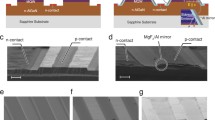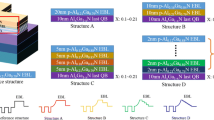Abstract
Owing to poor hole-injection efficiency, conventional AlGaN-based deep-ultraviolet (DUV) light-emitting diodes (LEDs) generally suffer from a seriously inhomogeneous carrier distribution in the quantum well region. This leads to uneven radiative recombination rates, seriously affecting the luminous efficiency. In this paper, however, we propose an asymmetric quantum well (AQW) near the interface between the last quantum barrier and the electron blocking layer to fully utilize the inhomogeneous distribution characteristics. The optoelectronic performances of conventional and a proposed DUV-LED with an AQW have been numerically simulated and analyzed. The results reveal that electrons and holes tend to gather and recombine in the AQW region. This significantly enhances the internal quantum efficiency and the light output power with an improvement of about 120%, although it increases the peak emission wavelength red-shift. The peak emission wavelength of the AQW can be adjusted to the wavelength of the original structure while keeping a high optical efficiency by simply increasing the Al composition.







Similar content being viewed by others
References
J. Simon, V. Protasenko, C. Lian, H. Xing, and D. Jena, Science 327, 60 (2010).
C. He, W. Zhao, H. Wu, S. Zhang, K. Zhang, L. He, N. Liu, Z. Chen, and B. Shen, Cryst. Growth Des. 18, 6816 (2018).
C. Chu, K. Tian, J. Che, H. Shao, J. Kou, Y. Zhang, Y. Li, M. Wang, Y. Zhu, and Z. Zhang, Opt. Express 27, A620 (2019).
S.M. Islam, K. Lee, J. Verma, V. Protasenko, S. Rouvimov, S. Bharadwaj, H. Xing, and D. Jena, Appl. Phys. Lett. 110, 041108 (2017).
C. Liu, Y.K. Ooi, S.M. Islam, H. Xing, D. Jena, and J. Zhang, Appl. Phys. Lett. 112, 011101 (2018).
H. Sun, M.K. Shakfa, M.M. Muhammed, B. Janjua, K. Li, R. Lin, T.K. Ng, I.S. Roqan, B.S. Ooi, and X. Li, ACS Photonics 5, 964 (2017).
W. Guo, H. Sun, B. Torre, J.Q. Li, M. Sheikhi, J. Jiang, H. Li, S. Guo, K. Li, and R. Lin, Adv. Func. Mater. 28, 1802395 (2018).
K.B. Nam, M.L. Nakarmi, J. Li, J.Y. Lin, and H.X. Jiang, Appl. Phys. Lett. 83, 878 (2003).
Y.H. Liang, and E. Towe, Appl. Phys. Rev. 5, 011107 (2018).
Q. Wang, L. He, L. Wang, C. Li, and M. He, Opt. Commun. 478, 126380 (2020).
L. Li, Y. Zhang, S. Xu, W. Bi, Z. Zhang, and H. Kuo, Materials 10, 1221 (2017).
J. Piprek, and Z.M.S. Li, Appl. Phys. Lett. 102, 2217 (2013).
M. Katsuragawa, S. Sota, M. Komori, C. Anbe, T. Takeuchi, H. Sakai, H. Amano, and I. Akasaki, J. Cryst. Growth 189, 528 (1998).
Y.A. Yin, N. Wang, S. Li, Y. Zhang, and G. Fan, Appl. Phys. A. 119, 41 (2015).
A. Pandey, W.J. Shin, X. Liu, and Z. Mi, Opt. Express. 27, A738 (2019).
K. Kojima, K. Furusawa, Y. Yamazaki, H. Miyake, K. Hiramatsu, and S.F. Chichibu, Appl. Phys. Express 10, 015802 (2016).
H. Yu, Q. Chen, Z. Ren, M. Tian, and H. Sun, IEEE Photonics J. 11, 1 (2019).
Y. Hou, Z. Guo, Y. Liu, M. Guo, J. Huang, and Z. Xu, Superlattice Microstruct. 107, 278 (2017).
J.A. Davidson, P. Dawson, T. Wang, T. Sugahara, J.W. Orton, and S. Sakai, Semiconductor Sci. Tech. 15, 497 (2000).
L. He, W. Zhao, K. Zhang, C. He, H. Wu, X. Liu, X. Luo, S. Li, and Z. Chen, Opt. Lett. 12, 062013.1 (2019).
J. Chen, T. Lu, H. Kuo, K.L. Fang, K.F. Huang, C.W. Kuo, C. Chang, C. Kuo, and S. Wang, IEEE Photonic Tech. Lett. 22, 860 (2010).
Y. Kuo, J. Chang, F. Chen, Y. Shih, and H. Chang, IEEE J. Quantum Electron. 52, 1 (2016).
K. Tian, Q. Chen, C. Chu, M. Fang, L. Li, Y. Zhang, W. Bi, C. Chen, Z. Zhang and J. Dai, Phys. Status solidi-R.1700346 (2017).
Z. Zhang, J. Kou, S.H. Chen, H. Shao, J. Che, C. Chu, K. Tian, Y. Zhang, W. Bi, and H. Kuo, Photonics Res. 7, B1 (2019).
V. Fiorentini, F. Bernardini, and O. Ambacher, Appl. Phys. Lett. 80, 1204 (2002).
L. He, W. Zhao, K. Zhang, C. He, H. Wu, N. Liu, W. Song, Z. Chen, and S. Li, Opt. Lett. 43, 515 (2018).
S.H. Wei, and A. Zunger, Appl. Phys. Lett. 69, 2719 (1996).
M.A. Khan, N. Maeda, M. Jo, Y. Akamatsu, R. Tanabe, Y. Yamada, and H. Hirayama, J. Mater. Chem. C. 7, 143 (2019).
I. Vurgaftman, and J.R. Meyer, J. Appl. Phys. 94, 3675 (2003).
Y.K. Kuo, J.Y. Chang, H.T. Chang, F.M. Chen, Y.H. Shih, and B.T. Liou, IEEE J. Quantum Electron. 53, 1 (2017).
Acknowledgments
This work was supported by the National Key Research and Development Program of Ministry of Science and Technology (Grant No. 2018YFB0406601), Key-Area Research and Development Program of Guangdong Province (No. 2020B010172001), the National Natural Science Foundation of China (61875187), the GDAS’ Project of Science and Technology Development (2019GDASYL-0105062, 2020GDASYL-20200103117, 2018GDASCX-0112, 2019GDASYL-0103072 and 2020GDASYL-20200104031), and the Pearl River S&T Nova Program of Guangzhou (Grant No. 201806010087), Guangzhou Municipal Science and Technology Bureau (201904010140), Natural Science Foundation of Guangdong Province (No. 2018A0303130334).
Author information
Authors and Affiliations
Corresponding author
Ethics declarations
Conflict of interest
The authors declare that they have no conflict of interests.
Additional information
Publisher's Note
Springer Nature remains neutral with regard to jurisdictional claims in published maps and institutional affiliations.
Supplementary Information
Below is the link to the electronic supplementary material.
Rights and permissions
About this article
Cite this article
Wang, Q., Zhang, K., Li, C. et al. Modulating Carrier Distribution for Efficient AlGaN-Based Deep Ultraviolet Light-Emitting Diodes by Introducing an Asymmetric Quantum Well. J. Electron. Mater. 50, 2643–2648 (2021). https://doi.org/10.1007/s11664-021-08831-w
Received:
Accepted:
Published:
Issue Date:
DOI: https://doi.org/10.1007/s11664-021-08831-w




